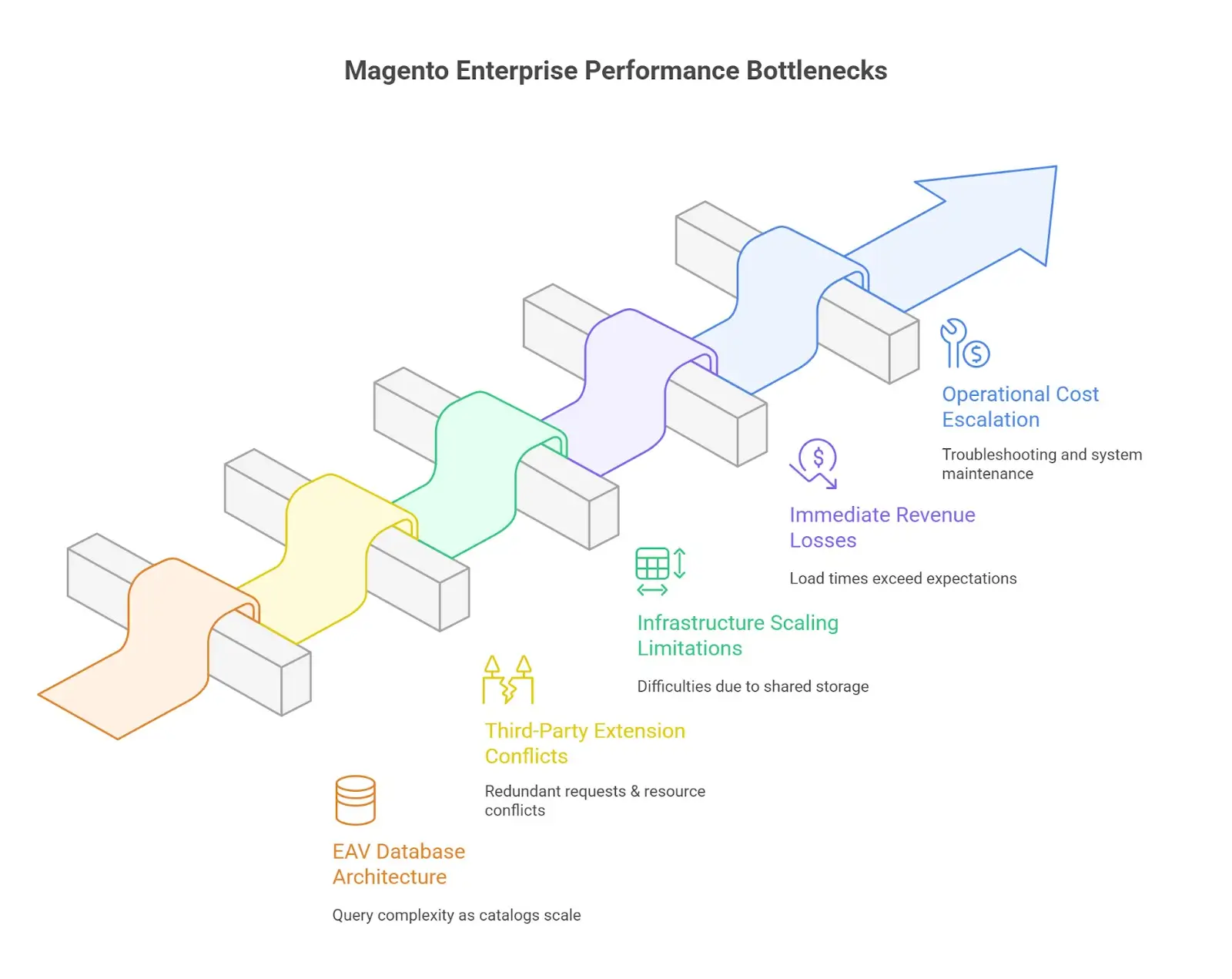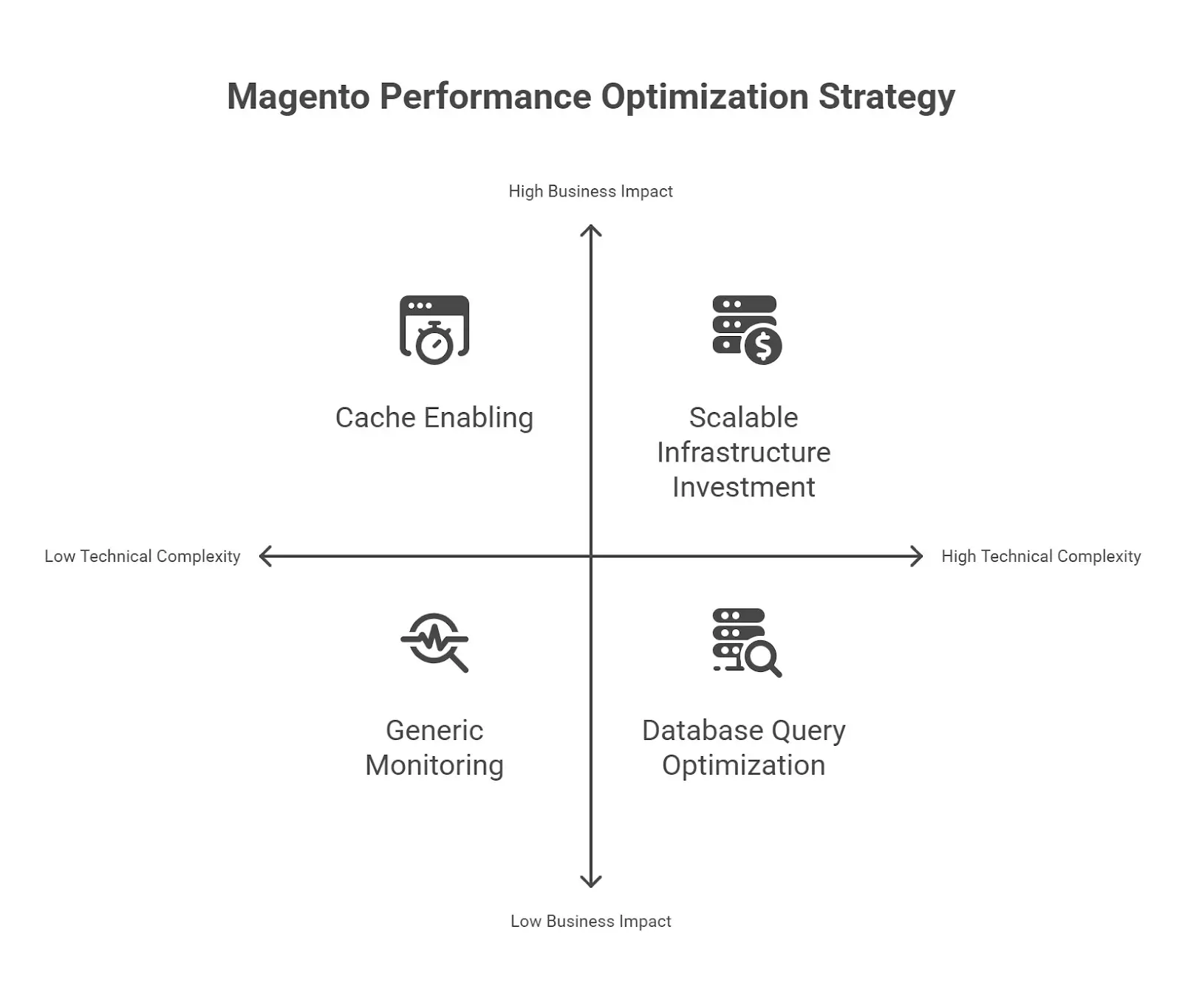JBL Clip 5 - Ultra-Portable, Waterproof & Dustproof Bluetooth Speaker, Big Pro Sound with Punchy bass, Integrated Carabiner, Up to 12 Hours of Play, Made in Part with Recycled Materials (Black)
$54.97 (as of December 1, 2025 07:27 GMT +00:00 - More infoProduct prices and availability are accurate as of the date/time indicated and are subject to change. Any price and availability information displayed on [relevant Amazon Site(s), as applicable] at the time of purchase will apply to the purchase of this product.)Enterprise e-commerce platforms face unprecedented performance pressures in 2025.
For the many websites powered by Magento, including industry leaders like Nike, Hermès, and Ford, performance optimization has evolved from technical maintenance to strategic revenue protection.
Traditional monitoring approaches fail because they treat Magento as a generic web application, missing the platform’s complex Entity-Attribute-Value database architecture, third-party extension conflicts, and enterprise-specific scalability challenges.
The result?
Teams spend 60% of their time on reactive firefighting instead of strategic performance management.
This guide provides enterprise decision-makers with a comprehensive framework for identifying, diagnosing, and resolving Magento performance issues through proven strategies that deliver measurable ROI.
What Drives Magento Performance Issues in Enterprise Environments?
With global e-commerce sales reaching $25.93 trillion and mobile commerce driving 72.9% of transactions, every millisecond of delay directly impacts your bottom line.
Enterprise Magento deployments face unique performance challenges stemming from the platform’s architectural decisions and the complexity of enterprise requirements.
Unlike smaller installations, enterprise environments must handle:
- Extensive product catalogs
- Complex pricing rules
- Multiple integrations
- High-traffic scenarios that expose fundamental scalability limitations.
The EAV Database Architecture Challenge
The primary driver of performance issues lies in Magento’s Entity-Attribute-Value (EAV) database model.
While this architecture provides unparalleled flexibility for product catalog management, it creates exponential query complexity as catalogs scale.
Key impact factors include:
- Each product attribute requires separate database joins
- Simple product pages with 20 attributes execute 50+ database queries
- Every attribute added to Magento slows response time by 1-5ms
- Enterprise catalogs with 50,000+ SKUs experience 40% slower query response times
Third-Party Extension Ecosystem Conflicts
Enterprise Magento stores typically run 15-25 extensions to support complex business requirements.
However, most extensions operate independently, creating redundant data requests and resource conflicts.
Common extension-related issues:
- Unoptimized extensions can slow page loads
- Memory leaks from poorly coded extensions compound over time
- Each module added slows down code with “one-fits-all” logic
- Extension conflicts often remain undetected until traffic spikes occur
Infrastructure Scaling Limitations
Magento’s monolithic architecture creates horizontal scaling difficulties due to shared storage requirements for Varnish cache, media files, and configuration data.
Session management, cache invalidation, and file system dependencies prevent accurate stateless scaling, making cloud-native deployment complex and expensive.
The Business Impact of Poor Performance
Recent data reveals the stark reality: downtime costs Global 2000 companies $400 billion annually, representing 9% of total profits.
For enterprises dealing with Magento performance issues, they can expect the perfect storm of lost revenue, increased customer acquisition costs, and competitive disadvantage.
Performance issues translate directly to measurable business losses across multiple dimensions.
A single second of page load delay reduces conversions significantly, while many mobile users abandon sites that take longer than three seconds to load.
For an enterprise generating $100,000 monthly revenue, a two-second page load delay results in over $4,200 in lost monthly revenue.
Immediate Revenue Losses
- Mobile visitors abandon sites when load times exceed three seconds
- Customer acquisition costs increase when performance issues reduce conversion efficiency
- Cart abandonment rates spike during slow checkout processes
- Peak period revenue losses for major retailers
Operational Cost Escalation
- Teams spend more time on system maintenance and troubleshooting
- Support ticket volumes increase when performance affects user experience
- Infrastructure requirements grow exponentially to compensate for poor optimization
- Emergency optimization projects cost 3-5x more than proactive improvements

Why Traditional Performance Optimization Approaches Fall Short
Enterprise IT teams often apply generic web performance optimization strategies to deal with Magento performance issues, achieving limited results because they fail to address platform-specific architectural challenges.
Common Optimization Missteps
Generic Monitoring Tools Create False Confidence
- Server CPU utilization and memory metrics don’t correlate with user experience.
- Infrastructure-level monitoring misses application-layer bottlenecks
- Teams optimize servers while Magento-specific issues remain unaddressed
- Standard APM tools miss most Magento-specific performance issues
Database Optimization Without EAV Understanding
- Standard MySQL tuning strategies fail with Magento’s unique query patterns
- Traditional indexing approaches don’t address entity relationship complexity
- Generic optimization ignores attribute loading patterns specific to EAV architecture
- Performance improvements plateau quickly without specialized knowledge
The Hidden Costs of Reactive Management
Reactive performance management creates hidden costs that extend far beyond obvious revenue losses.
Technical debt accumulates when teams implement quick fixes rather than addressing architectural issues.
Resource Allocation Inefficiencies
- Teams spend 75% of their time on urgent issues rather than strategic improvements.
- Crisis-driven priorities prevent proactive optimization investments
- Organizations that spend adequate time on integration planning experience fewer implementation delays
- Enterprises save a lot annually by implementing Magento-native monitoring
How Should Enterprises Diagnose Magento Performance Issues?
Effective Magento performance diagnosis requires a systematic approach that addresses platform-specific architectural elements while maintaining business context.
Platform-Specific Monitoring Foundation
The diagnostic process begins with establishing baseline performance metrics using Magento-native monitoring tools.
Essential Diagnostic Capabilities
- Transaction tracing through the complete Magento execution flow
- Database query analysis specific to EAV architecture patterns
- Extension performance isolation and conflict detection
- Business metric correlation with technical performance data
Advanced Code-Level Analysis
Blackfire profiler delivers granular code-level analysis that reveals function-by-function performance characteristics, providing wall time, I/O time, CPU time, memory consumption, and query speed metrics.
Key diagnostic features include:
- Function-by-function execution time measurement
- Memory consumption analysis for custom code and extensions
- Database query performance correlation with code execution
- Automated performance regression detection through CI/CD integration
What Performance Monitoring Strategy Delivers Maximum ROI?
Effective Magento performance issues monitoring requires a multi-layered approach that combines real-time application performance tracking with business impact analysis.
Key Performance Indicators for Enterprise Success
Revenue-Focused KPIs
- Revenue per visitor correlated with page load times
- Cart abandonment rates related to checkout performance
- Customer lifetime value impact from site speed improvements
- Marketing campaign effectiveness during performance issues
User Experience Metrics
Essential user experience indicators include:
- Time to First Byte (target <800ms)
- First Contentful Paint and Largest Contentful Paint scores
- Core Web Vitals compliance rates
- Mobile performance optimization metrics
Operational Efficiency Indicators
- Cache hit ratios (target >95%)
- Database query performance trends and optimization opportunities
- Extension load impact analysis and performance correlation
- Infrastructure resource utilization patterns and scaling triggers
Automated Alerting and Response Protocols
Effective alerting systems prevent small performance issues from becoming major business disruptions.
Automated alerts should trigger based on business impact thresholds rather than arbitrary technical metrics.
Multi-Level Alerting Framework
- Warning-level alerts: Notify technical teams of developing issues before customer impact
- Critical alerts: Immediate management engagement and emergency response activation
- Business impact alerts: Revenue-threshold triggers for executive notification
- Predictive alerts: Capacity and performance trend warnings for proactive intervention
How Do You Optimize Magento’s Database Performance at Scale?
Database optimization represents the most critical factor in enterprise Magento performance because the platform’s EAV architecture creates unique scaling challenges.
Strategic Optimization Approaches
Advanced Caching Strategies
- Varnish full-page caching: Serves thousands of requests per second for cached content
- Redis integration: Session storage and backend caching remove database pressure
- Application-level caching: Block-level caching for frequently accessed content components
- Cache warming strategies: Preloading critical user journeys for optimal performance
ElasticSearch Implementation Benefits
- 60%+ reduction in catalog page load times
- Improved search result relevance and user experience
- Reduced MySQL database load for product filtering operations
- Enhanced scalability for extensive product catalogs
Which Integration Challenges Create the Biggest Performance Risks?
Enterprise Magento deployments typically require integration with 10-15 external systems, including:
- ERP platforms
- CRM systems
- Payment gateways
- Inventory management tools.
Each integration point creates potential performance bottlenecks.
Critical Integration Areas
ERP System Integration
Real-time inventory synchronization, pricing updates, and order processing require careful architecture to prevent database locks and resource contention.
We’ve observed cases where ERP integrations created 15-second page load delays during peak traffic periods.
Payment Gateway Optimization
High-latency payment processing, inadequate error handling, and insufficient connection pooling can reduce conversion rates by 25% or more during checkout processes.
Third-Party Service Dependencies
Shipping calculators, tax services, and fraud detection systems create external performance dependencies that enterprise teams can’t directly control, requiring circuit breaker patterns and caching strategies.
How Should You Measure Performance Optimization ROI?
Performance optimization ROI measurement requires connecting technical improvements with business outcomes through comprehensive metrics that track revenue impact, cost reduction, and operational efficiency improvements.
Performance Benchmarking and Success Metrics
Technical Performance Benchmarks
- Sub-800ms Time to First Byte achievement
- Under 3-second page load times across all devices
- 99.99% uptime targets
- 95%+ cache hit ratios
Business Impact Benchmarks
- Conversion rate improvements (target 20%+ increase)
- Revenue per visitor increases, and cart abandonment rate reductions
- Customer satisfaction score improvements and reduced support tickets
- Performance optimization typically pays for itself within the first month
ROI Calculation Framework
Calculate the total cost of ownership, including implementation costs, ongoing operational costs, and opportunity costs from delayed implementation.
Companies implementing systematic optimization achieve 516% ROI through revenue protection, cost reduction, and operational efficiency improvements.
What Are the Critical Implementation Pitfalls to Avoid?
Enterprise Magento performance optimization projects face predictable implementation challenges that can be avoided through proper planning and risk management.
Technical Implementation Challenges
Integration Complexity Underestimation
Organizations typically underestimate integration requirements, leading to project delays and budget overruns.
Successful implementations allocate 40% more time for integration planning and testing phases.
Performance Testing Inadequacy
Effective testing requires production-like environments, realistic traffic patterns, and comprehensive user journey validation that reflects actual customer behavior patterns.
Quick Wins vs. Strategic Priorities
Quick Wins (0-3 months, <$25K investment)
- Enable Magento built-in caching (Redis, Varnish)
- Image optimization and lazy loading implementation
- Critical CSS optimization for above-the-fold content
- Database query optimization for high-traffic pages
Strategic Priorities (6-18 months, $100K+ investment)
- Complete infrastructure modernization to cloud-native architecture
- Custom extension development and optimization programs
- Advanced monitoring and analytics implementation
- Comprehensive performance governance framework
Success Factors and Decision Frameworks
Build vs. Buy Considerations
- Build scenarios: Unique business logic requiring custom optimization, extensive proprietary system integration.
- Buy scenarios: Standard e-commerce functionality, limited internal resources, rapid implementation requirements
- Hybrid approach: Leverage Adobe Commerce Cloud for infrastructure, implement New Relic for monitoring, and custom-develop business-specific optimizations

Conclusion
Enterprise Magento performance issues stem from the platform’s unique architecture, third-party extension conflicts, and scaling challenges, directly affecting user experience and revenue.
Generic monitoring fails to detect these issues, making Magento-native tools like New Relic APM Pro and Blackfire profiler essential for accurate diagnosis.
Key performance indicators, including page load times, cache hit ratios, and business metrics—must guide optimization efforts.
To maximize ROI, enterprises should adopt a proactive, systematic strategy combining real-time technical monitoring with business impact analysis.
Prioritize cache enabling, database query optimization tailored to Magento’s EAV model, and extension streamlining.
Moving forward, invest in scalable infrastructure and robust monitoring to protect Magento’s performance as a critical revenue driver.
Frequently Asked Questions
Q: What is the typical ROI timeline for enterprise Magento performance optimization?
A: Most enterprises see ROI within 30 days through improved conversion rates, with full optimization benefits realized within 6 months. Studies show 516% ROI over 3 years from systematic optimization.
Q: How much should enterprises budget for comprehensive Magento performance optimization?
A: Budget $100-200K for complete enterprise optimization, including monitoring tools, infrastructure upgrades, and optimization services.
Q: Which performance issues provide the quickest wins for enterprise teams?
Implement Redis caching, optimize images, enable Varnish full-page cache, and deploy CDN services. These changes typically reduce page load times 40-60% within 30 days.
Q: What monitoring tools are essential for enterprise Magento performance management?
New Relic APM (embedded in Magento Enterprise Cloud) and Blackfire profiler provide Magento-specific monitoring. Additional tools include GTmetrix, Google PageSpeed Insights, and custom business metric dashboards.
Q: How do you prevent performance degradation after optimization implementation?
Establish continuous monitoring, automated alerting for performance thresholds, regular performance audits, and code review processes that prevent performance regressions from accumulating over time.
Q: What infrastructure changes provide the most significant performance improvements?
Migration to cloud-native hosting (Adobe Commerce Cloud), implementation of auto-scaling capabilities, CDN deployment, and database optimization typically provide 50-80% performance improvements for enterprise deployments.
Read more: Commercetools vs Magento: Which E‑Commerce Platform Wins in 2025?
Source: https://ecommerce.folio3.com/blog/magento-performance-issues-diagnosis/

